Characterisation of Biological Materials at THz Frequencies by Attenuated Total Reflection: Lard
Abstract
1. Introduction
1.1. Penetration Depth of THz: Bio-Medical Applications
1.2. Attenuated Total Reflection
2. Experimental: Setups and Samples
2.1. Synchrotron Radiaton and ATR
2.2. Modeling
3. Results and Discussion
3.1. Polarisation of Synchrotron Radiation
3.2. THz Spectra of Lard
3.3. ATR Experimental and Numerical Data
4. Conclusions and Outlook
Author Contributions
Funding
Conflicts of Interest
Appendix A. Phase Changes in ATR
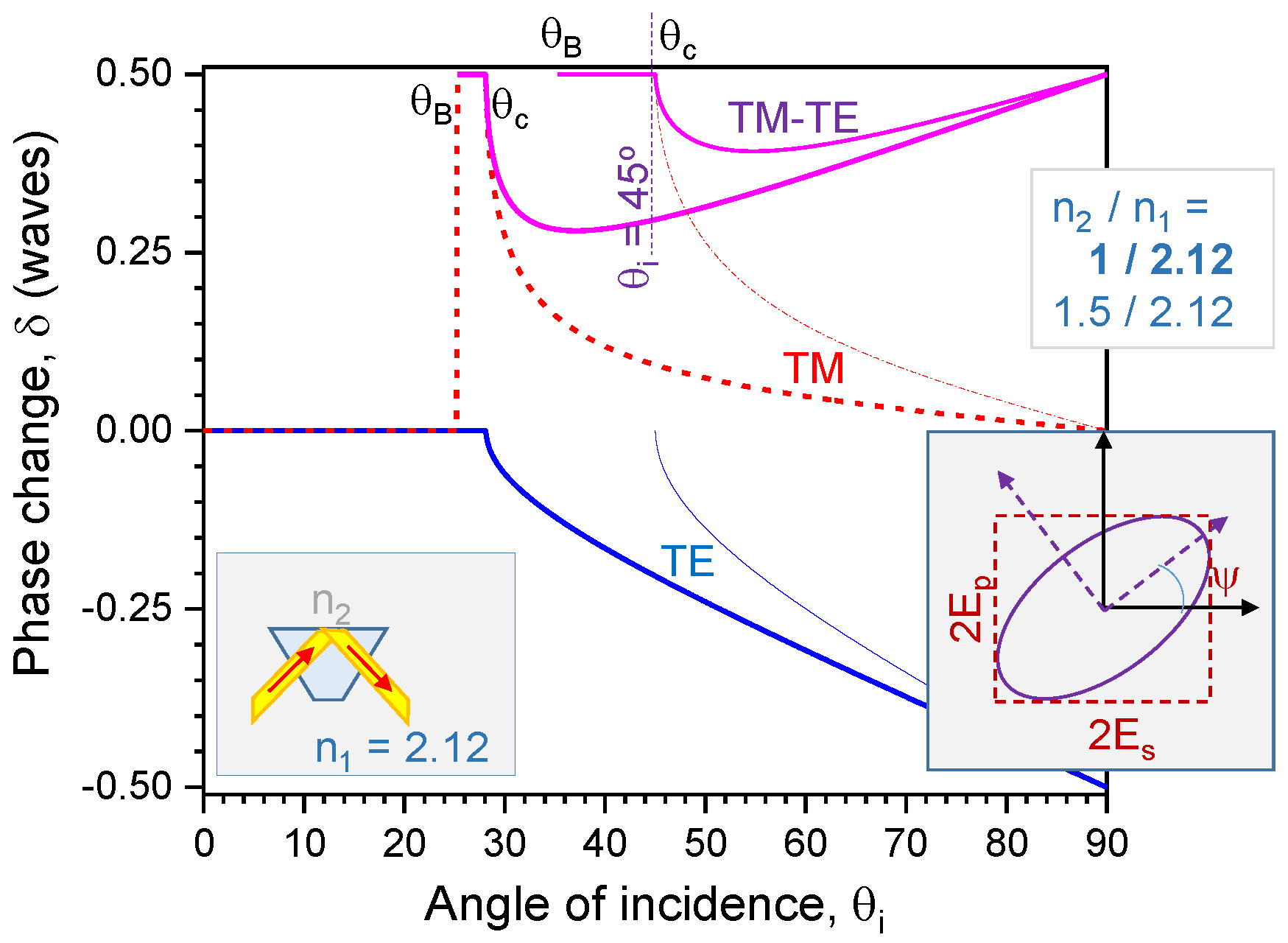
References
- Xia, J.; Yao, J.; Wang, L. Photoacoustic Tomography: Principles and Advances; Electromagnetic Waves: Cambridge, MA, USA, 2014. [Google Scholar]
- Waldstein, S.M.; Faatz, H.; Szimacsek, M.; Glodan, A.M.; Podkowinski, D.; Montuoro, A.; Simader, C.; Gerendas, B.S.; Schmidt-Erfurth, U. Comparison of penetration depth in choroidal imaging using swept source vs. spectral domain optical coherence tomography. Eye 2015, 29, 409–415. [Google Scholar] [CrossRef] [PubMed]
- Olsovsky, C.; Shelton, R.; Carrasco-Zevallos, O.; Applegate, B.; Maitland, K. Chromatic confocal microscopy for multi-depth imaging of epithelial tissue. Biomed. Opt. Express 2013, 4, 732–740. [Google Scholar] [CrossRef] [PubMed]
- Botar-Jid, C.; Cosgarea, R.; Bolboacǎ, S.; Şenilǎ, S.; Lenghel, L.; Rogojan, L.; Dudea, S. Assessment of Cutaneous Melanoma by Use of Very- High-Frequency Ultrasound and Real-Time Elastography. Am. J. Roentgenol. 2016, 206, 699–704. [Google Scholar] [CrossRef] [PubMed]
- Drakaki, E.; Sianoudis, I.; Zois, E.; Makropoulou, M.; Serafetinides, A.; Dessinioti, C.; Stefanaki, E.; Stratigos, A.; Antoniou, C.; Katsambas, A.; et al. Non-invasive spectroscopic techniques in the diagnosis of non-melanoma skin cancer. J. Phys. Conf. Ser. 2017, 931, 012036. [Google Scholar] [CrossRef]
- Available online: https://www.canceraustralia.gov.au/affected-cancer/cancer-types/melanoma/statistics (accessed on 10 November 2020).
- Erdmann, F.; Lortet Tieulent, J.; Schūz, J.; Zeeb, H.; Greinert, R.; Breitbart, E.W.; Bray, F. International trends in the incidence of malignant melanoma 1953–2008—Are recent generations at higher or lower risk? Int. J. Cancer 2012, 132, 385–400. [Google Scholar] [CrossRef] [PubMed]
- Wheatley, K.; Wilson, J.S.; Gaunt, P.; Marsden, J.R. Surgical excision margins in primary cutaneous melanoma: A meta-analysis and Bayesian probability evaluation. Cancer Treat. Rev. 2016, 42, 73–81. [Google Scholar] [CrossRef]
- Keung, E.; Gershenwald, J. The eighth edition American Joint Committee on Cancer (AJCC) melanoma staging system: Implications for melanoma treatment and care. Expert Rev. Anticancer Ther. 2018, 18, 775–784. [Google Scholar] [CrossRef]
- Landow, S.; Gjelsvik, A.; Weinstock, M. Mortality burden and prognosis of thin melanomas overall and by subcategory of thickness, SEER registry data, 1992–2013. J. Am. Acad. Derm. 2017, 76, 258–263. [Google Scholar] [CrossRef]
- Hasted, J.; Husain, S.; Frescura, F.A.M.; Birch, J.R. The temperature variation of the near millimetre wavelength optical constants of water. Infrared Phys. 1987, 27, 11–15. [Google Scholar] [CrossRef]
- Liebe, H.; Hufford, G.; Manabe, T. A model for the complex permittivity of water at frequencies below 1 THz. Int. J. Infrared Millim. Waves 1991, 12, 659–675. [Google Scholar] [CrossRef]
- Zhang, C.; Lee, K.; Zhang, X.; Wei, X.; Shen, Y. THz spectroscopy of ice. Lasers Electro-Opt. Soc. IEEE 2002, 2, 646–647. [Google Scholar]
- Woodward, R.M.; Cole, B.E.; Wallace, V.P.; Pye, R.J.; Arnone, D.D.; Linfield, E.H.; Pepper, M. Terahertz pulse imaging in reflection geometry of human skin cancer and skin tissue. Phys. Med. Biol. 2002, 47, 3853–3863. [Google Scholar] [CrossRef] [PubMed]
- Ashworth, P.; Zeitler, J.; Pepper, M.; Wallace, V. Terahertz spectroscopy of biologically relevant liquids at low temperatures. In Proceedings of the Infrared Millimeter Waves and 14th International Conference on Teraherz Electronics, Shanghai, China, 18–22 September 2006; p. 184. [Google Scholar]
- Nakajima, S.; Hoshina, H.; Yamashita, M.; Otani, C. Terahertz imaging diagnostics of cancer tissues with a chemometrics technique. Appl. Phys. Lett. 2007, 90, 041102. [Google Scholar] [CrossRef]
- Warner, R.; Myers, M.; Taylor, D. Electron probe analysis of human skin: Determination of the water concentration profile. J. Investig. Derm. 1988, 190, 218–224. [Google Scholar] [CrossRef]
- Rofstad, E.; Steinsland, E.; Kaalhus, O.; Chang, Y.; Høvik, B.; Lyng, H. Magnetic Resonance Imaging of Human Melanoma Xenografts in Vivo: Proton Spin–lattice and Spin–spin Relaxation Times Versus Fractional Tumour Water Content and Fraction of Necrotic Tumour Tissue. Int. J. Radiat. Biol. 1994, 165, 387–401. [Google Scholar] [CrossRef]
- Huang, H.H.; Nagashima, T.; Yonezawa, T.; Matsuo, Y.; Ng, S.H.; Juodkazis, S.; Hatanaka, K. Giant Enhancement of THz Wave Emission under Double-Pulse Excitation of Thin Water Flow. Appl. Sci. 2020, 10, 2031. [Google Scholar] [CrossRef]
- Fülöp, J.; Tzortzakis, S.; Kampfrath, T. Laser-Driven Strong-Field Terahertz Sources. Adv. Opt. Mat. 2020, 8, 1900681. [Google Scholar] [CrossRef]
- Huang, H.H.; Nagashima, T.; Hsu, W.H.; Juodkazis, S.; Hatanaka, K. Dual THz Wave and X-ray Generation from a Water Film under Femtosecond Laser Excitation. Nanomaterials 2018, 8, 523. [Google Scholar] [CrossRef]
- Watts, K.; Fairchild, R.; Slatkin, D.; Greenberg, D.; Packer, S.; Atkins, H.; Hannon, S. Melanin content of hamster tissues, human tissues, and various melanomas. Cancer Res. 1981, 41, 467–472. [Google Scholar]
- Vilagosh, Z.; Lajevardipour, A.; Wood, A.W. Computational absorption and reflection studies of normal human skin at 0.45 THz. Biomed. Opt. Express 2020, 11, 417–431. [Google Scholar] [CrossRef]
- Reid, C.; Pickwell-MacPherson, E.; Laufer, J.; Gibson, A.; Hebden, J.; Wallace, V. Accuracy and resolution of THz reflection spectroscopy for medical imaging. Phys. Med. Biol. 2010, 55, 4825–4838. [Google Scholar] [CrossRef] [PubMed]
- Ramer, G.; Lendl, B. Attenuated Total Reflection Fourier Transform Infrared Spectroscopy. In Encyclopedia of Analytical Chemistry: Online; John Wiley and Sons, Ltd.: Berlin, Germany, 2013. [Google Scholar]
- Hansen, W.N. Expanded formulas for attenuated total reflection and the derivation of absorption rules for single and multiple ATR spectrometer cells. Spectrochim. Acta 1965, 21, 815–833. [Google Scholar] [CrossRef]
- Ryu, M.; Linklater, D.; Hart, W.; Balcytis, A.; Skliutas, E.; Malinauskas, M.; Appadoo, D.; Tan, Y.; Ivanova, E.P.; Morikawa, J.; et al. 3D printed polarizing grids for IR-THz synchrotron radiation. J. Opt. 2018, 20, 035101. [Google Scholar] [CrossRef]
- Heyden, M.; Sun, J.; Funkner, S.; Mathias, G.; Forbert, H.; Havenith, M.; Marx, D. Dissecting the THz spectrum of liquid water from first principles via correlations in time and space. Proc. Natl. Acad. Sci. USA 2010, 107, 12068–12073. [Google Scholar] [CrossRef]
- Goormaghtigh, E.; Raussens, V.; Ruysschaert, J.M. Attenuated total reflection infrared spectroscopy of proteins and lipids in biological membranes. Biochim. Biophys. Acta 1999, 1422, 105–185. [Google Scholar] [CrossRef]
- Honda, R.; Ryu, M.; Moritake, M.; Balcytis, A.; Mizeikis, V.; Vongsvivut, J.; Tobin, M.J.; Appadoo, D.; Li, J.L.; Ng, S.H.; et al. Hyperspectral mapping of anisotropy. Nanoscale Horiz. 2019, 4, 1443–1449. [Google Scholar]
- Honda, R.; Ryu, M.; Moritake, M.; Balcytis, A.; Mizeikis, V.; Vongsvivut, J.; Tobin, M.J.; Appadoo, D.; Li, J.L.; Ng, S.H.; et al. Infrared Polariscopy Imaging of Linear Polymeric Patterns with a Focal Plane Array. Nanomaterials 2019, 9, 732. [Google Scholar] [CrossRef]
- Honda, R.; Ryu, M.; Balcytis, A.; Vongsvivut, J.; Tobin, M.J.; Juodkazis, S.; Morikawa, J. Paracetamol micro-structure analysis by optical mapping. Appl. Surf. Sci. 2019, 473, 127–132. [Google Scholar] [CrossRef]
- Porterfield, D.; Hesler, J.; Densing, R.; Mueller, E.; Crowe, T.; Weikle, R. Resonant metal-mesh bandpass filters for the far infrared. Appl. Opt. 1994, 33, 6046–6052. [Google Scholar] [CrossRef]
- Balčytis, A.; Ryu, M.; Seniutinas, G.; Nishijima, Y.; Hikima, Y.; Zamengo, M. Si-based infrared optical filters. Opt. Eng. 2015, 54, 127103. [Google Scholar] [CrossRef]
- Mizeikis, V.; Kowalska, E.; Ohtani, B.; Juodkazis, S. Light-field enhancement for the photo-catalytic applications. Phys. Status Solidi Rapid Res. Lett. 2010, 4, 268–270. [Google Scholar] [CrossRef]
- Li, Z.Z.; Wang, L.; Fan, H.; Yu, Y.H.; Chen, Q.D.; Juodkazis, S.; Sun, H.B. O-FIB: Far-field-induced near-field breakdown for direct nanowriting in an atmospheric environment. Light Sci. Appl. 2020, 9, 41. [Google Scholar] [CrossRef] [PubMed]
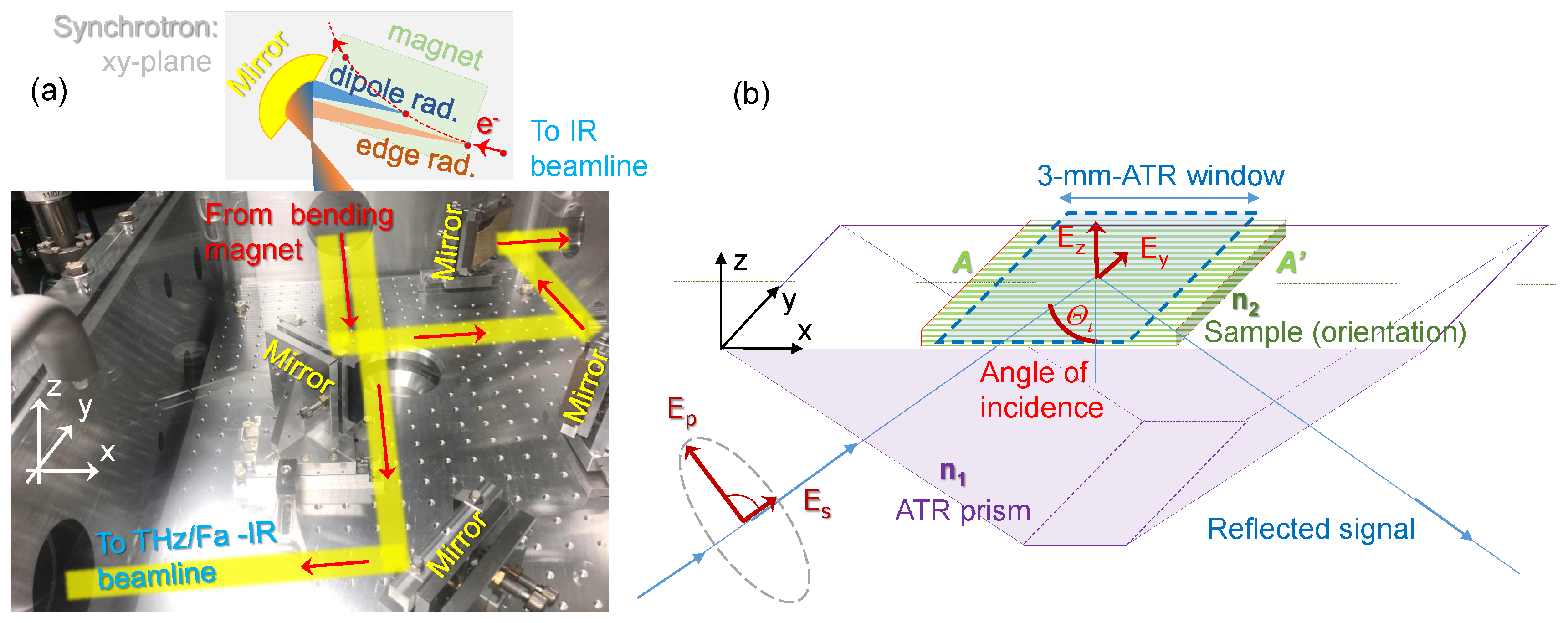

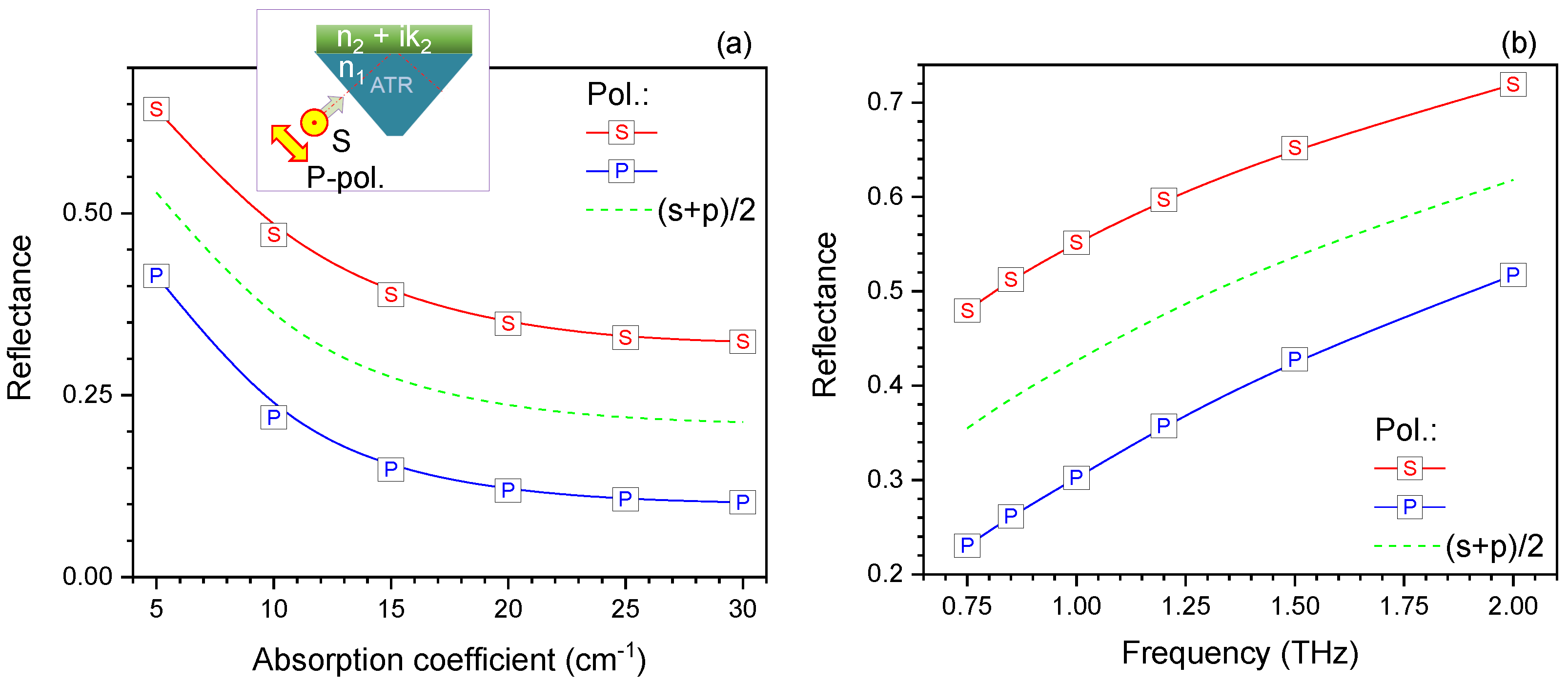
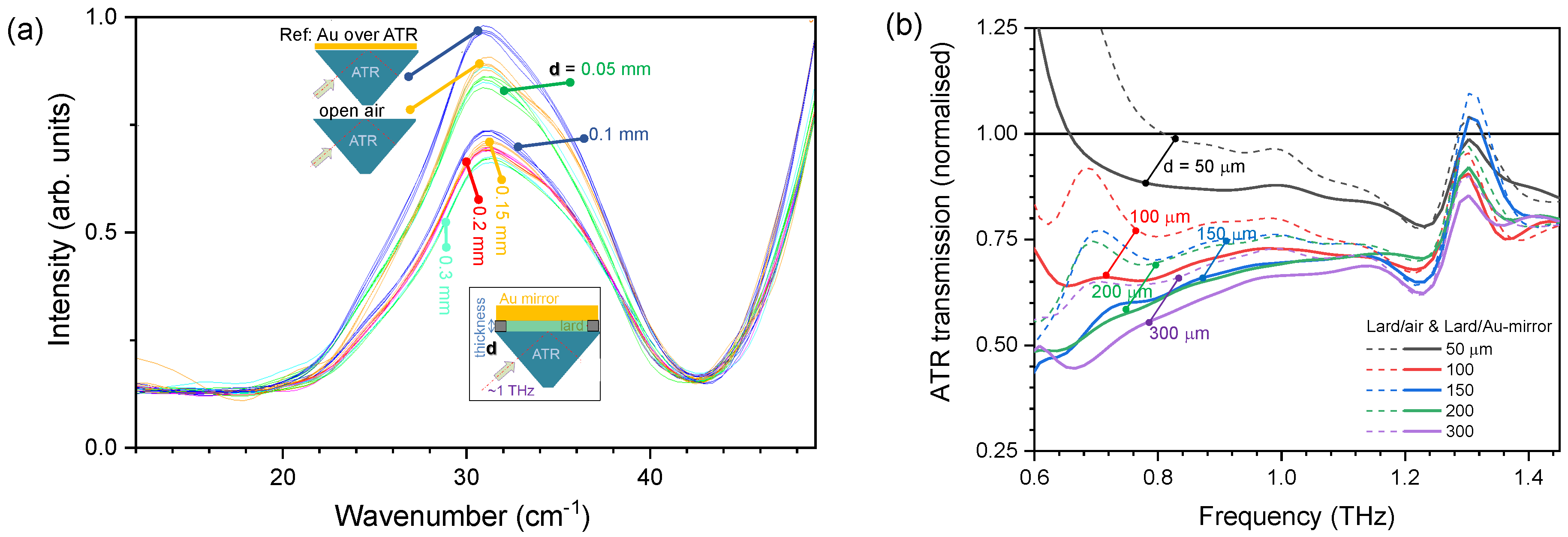
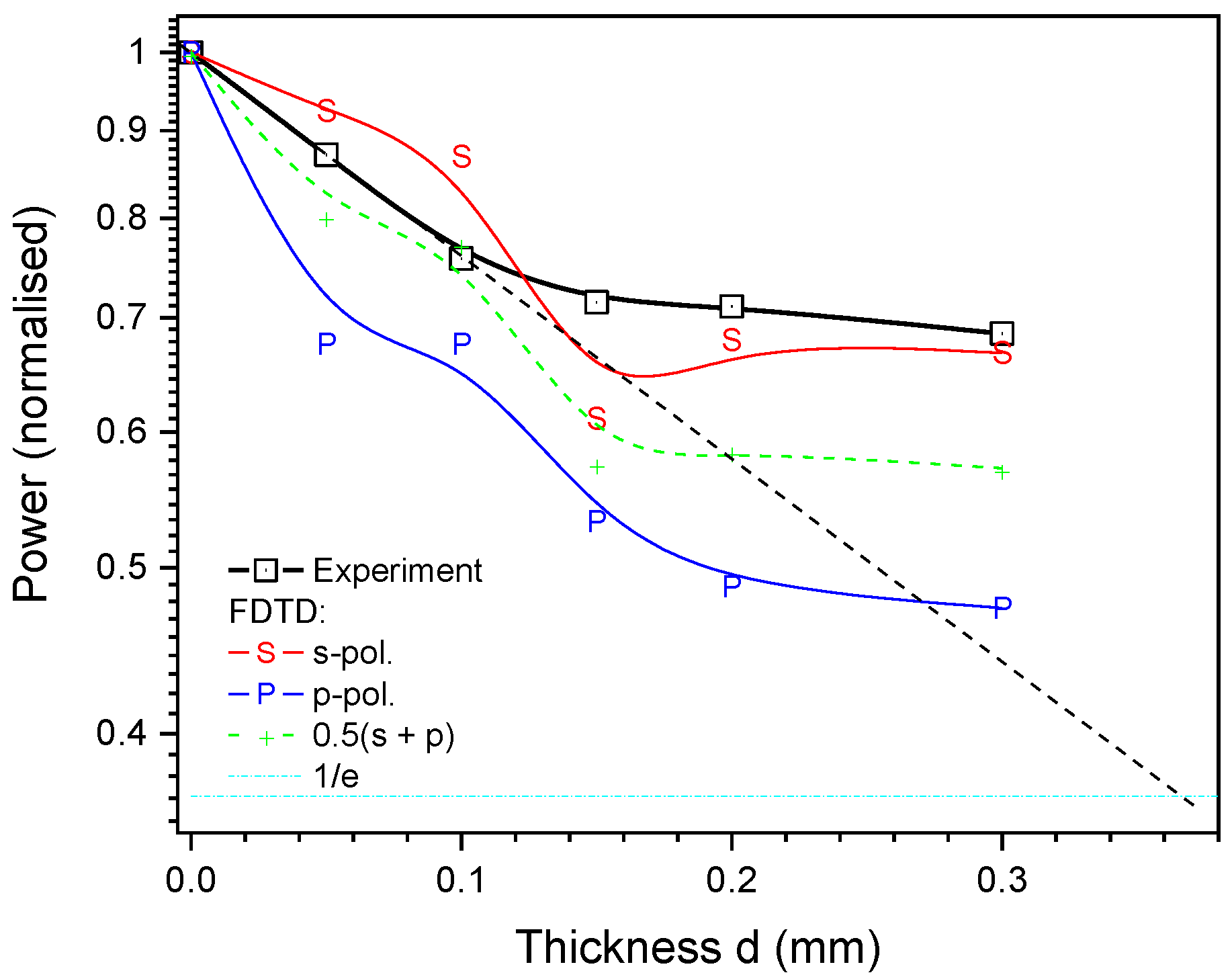
Publisher’s Note: MDPI stays neutral with regard to jurisdictional claims in published maps and institutional affiliations. |
© 2020 by the authors. Licensee MDPI, Basel, Switzerland. This article is an open access article distributed under the terms and conditions of the Creative Commons Attribution (CC BY) license (http://creativecommons.org/licenses/by/4.0/).
Share and Cite
Vilagosh, Z.; Lajevardipour, A.; Appadoo, D.; Ng, S.H.; Juodkazis, S.; Wood, A.W. Characterisation of Biological Materials at THz Frequencies by Attenuated Total Reflection: Lard. Appl. Sci. 2020, 10, 8692. https://doi.org/10.3390/app10238692
Vilagosh Z, Lajevardipour A, Appadoo D, Ng SH, Juodkazis S, Wood AW. Characterisation of Biological Materials at THz Frequencies by Attenuated Total Reflection: Lard. Applied Sciences. 2020; 10(23):8692. https://doi.org/10.3390/app10238692
Chicago/Turabian StyleVilagosh, Zoltan, Alireza Lajevardipour, Dominique Appadoo, Soon Hock Ng, Saulius Juodkazis, and Andrew W. Wood. 2020. "Characterisation of Biological Materials at THz Frequencies by Attenuated Total Reflection: Lard" Applied Sciences 10, no. 23: 8692. https://doi.org/10.3390/app10238692
APA StyleVilagosh, Z., Lajevardipour, A., Appadoo, D., Ng, S. H., Juodkazis, S., & Wood, A. W. (2020). Characterisation of Biological Materials at THz Frequencies by Attenuated Total Reflection: Lard. Applied Sciences, 10(23), 8692. https://doi.org/10.3390/app10238692






